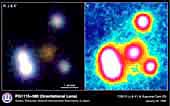Press Release
PG1115+080 (Gravitational Lens)
January 28, 1999
 Low Res. (94 KB) High Res. (411 KB) |
Object Name: PG1115+080 (Gravitational Lens) Telescope: Subaru Telescope / Cassegrain Focus Instrument: CISCO (J, K'), Suprime-Cam (R) Filter: R (red), J (1.25 micron), K' (2.15 micron) Color: Blue (R), Green (J), Red (K') Date: UT 1999 Jan 13 (R), Jan 14 (J), Jan 12 (K') Exposure: 420 sec (R), 35 sec (J), 275 sec (K') Field of View: 4.7 arcsec by 5 arcsec Orientation: North up, east left |
Explanation:
Einstein's Theory of General Relativity predicts that the
gravitational pull from massive objects is able to deflect
rays of light in the same way as do lenses. Many examples
of this "gravitational lensing" have been discovered,
where light from a distant object is deflected by an intervening
galaxy or group of galaxies whose gravity deforms the space
around them. Subaru has observed one such object, known
as PG1115+080, where a distant quasar (10 billion light
years away) is located almost directly behind a much closer
galaxy (3 billion light years away). When the alignment
is as good as this, light can take multiple routes from
the quasar to the observer, and many images are seen. The
left panel, a combination of optical and near-infrared images,
shows four bright images of the quasar around the central,
red galaxy which is acting as the lens. The excellent image
quality obtained by Subaru (0.33 arcsec FWHM for this image)
clearly separates all the images. The panel on the right
shows faint, extended light suggestive of a ring which is
expected when the source and lensing galaxy are this closely
aligned. Astronomers can use the relative brightness and
position of the individual images in a gravitationally-lensed
system to determine how rapidly the Universe is expanding
and whether it will continue to expand forever, or if it
will eventually slow down and collapse in a Big Crunch.